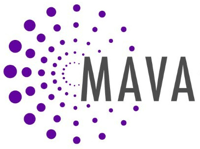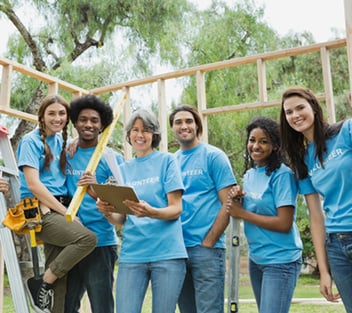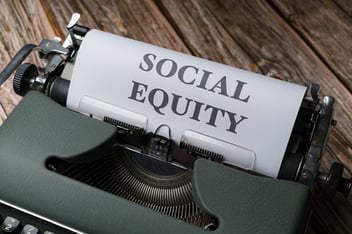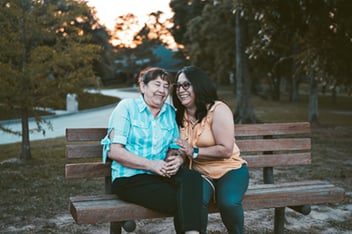This article originally appeared on www.mavanetwork.org and is featured here in partnership with the Minnesota Alliance for Volunteer Advancement.
![]()
By Lisa Joyslin, Minnesota Association for Volunteer Advancement (MAVA)
Best practice : a procedure that has been shown by research and experience to produce optimal results and that is established or proposed as a standard suitable for widespread adoption (Merriam-Webster)
The idea of “best practices” is a key part of nonprofit lingo and a concept touted by volunteer engagement leaders as we work to build our profession.
It can be a helpful term, and a helpful concept. But it can also be harmful.
There has been research to show that “best practices” don’t always translate across cultures. This is certainly true. But I believe the problem is even deeper than that.
“Best practices” are, in many ways, a reflection of white supremacy culture at work in the systems by which we engage volunteers and deliver services to communities. Earlier this year I wrote an article on how the characteristics of white supremacy culture show up in volunteer engagement. One of those characteristics is “only one right way,” described by Kenneth Jones and Tema Okun as “the belief there is one right way to do things and once people are introduced to the right way, they will see the light and adopt it.”
This is exactly what we’re referring to when we talk about a “best practice.” It is the one right way that everyone should adopt.
So, we teach others and build our nonprofits and volunteer engagement systems based on these best practices. But we forget to stop and ask a key question:
Best practices for whom?
The answer, often, is this: Best practices for people with privilege. In the nonprofit sector – and, more specifically, in volunteer engagement – this means best practices for affluent white people. This is not always intentional, and as Jerome Tennille outlines in a recent article, is in part due to centuries of racism at work in our country and our systems. But intentional or not, centering whiteness is harmful to those who are not part of the dominant culture.
That is the problem with “one right way.” It works for the people who create that one way – most likely people with power and privilege. It does not always work well for anyone else.
In the case of nonprofits, our “best practices” often do not work well for the very communities being supported by our programs. In fact, what we promote as “best practices” may serve as barriers for engaging with BIPOC communities and volunteers.
Here are a few examples of how this plays out within volunteer engagement:
Volunteer Onboarding
Most nonprofit volunteer programs have a specific volunteer onboarding processes for those interested in becoming a volunteer. It usually goes something like this: application, orientation, interview, background check, and training. Sometimes there are adjustments for certain positions – for example, office positions may not need a background check, or one-time volunteers may have an abbreviated process. That being said, most ongoing volunteers at any given organization go through the same process to become a volunteer. And, through MAVA’s ongoing research, we’ve heard time and time again that this extended process is not appealing for many BIPOC volunteers. If you’ve grown up with informal volunteerism – neighbors helping neighbors – as is the case in many BIPOC communities, the hoops volunteers must jump through to assist at a nonprofit are barriers that don’t make sense when you’re trying to help others.
This isn’t to say that background checks aren’t necessary for some positions, or that training should never be required. But…what if there wasn’t one right way to onboard volunteers? What if we dismantled the best practices we’ve held up around onboarding and created many ways to bring volunteers into the fold of our nonprofit volunteer programs? This may look different for every organization and every community, and there’s no roadmap for how to get there. It creates more work because we can’t make everyone fit into our “one right way.” But it’s a first step to dismantling systemic racism in our volunteer structures.
Recruiting New Volunteers
Volunteer engagement leaders get quite creative when it comes to recruiting new volunteers, so it may be a surprise to see recruitment as an example of harmful “best practices.” It’s true that there are many recruitment methods taught and practiced in volunteer engagement circles. However, these methods often have one thing in common: they require the volunteer to seek out the opportunity. Volunteer engagement leaders may not specify this as a best practice, but when you look at recruitment methods you’ll see that it’s usually the case. We post opportunities on websites and job boards, ask partners and community groups to promote our volunteer opportunities, and host booths at volunteer fairs.
But what about people who don’t see themselves as a “volunteer”? People who grew up helping others but not using the term “volunteer” – as is the case in many BIPOC communities – may not seek out formal opportunities. People who are working several jobs or experiencing poverty may not feel they’re able to “volunteer,” as they associate it with working without being paid. People who do not have a higher education, extensive job experience or an abundance of extra time may not be looking for volunteer opportunities. But, if you can meet these individuals where they’re at, build a relationship, and invite them to help their community through your organization, you might find an amazing volunteer with different lived experience than the volunteers who sought out your organization.
Are you actively building authentic relationships in BIPOC communities to learn more about their needs, how they give their time, and the talents they could bring to your work? When you do that, it allows you to make personal invitations and connect with people who – for many reasons – may not seek out opportunities. There’s no “one right way” when it comes to building relationships, and that should be the case with volunteer recruitment as well.

Like this article?
Get more like it, plus access to exclusive reports, training, and networking events by joining MAVA's network of Volunteer Engagement Professionals.
Goal Setting
The importance of building relationships brings me to this: our best practices for setting goals do not account for the intangibles of relationship-building. Many organizations promote SMART goals – goals that are Specific, Measurable, Achievable, Relevant and Time-bound. You know what is difficult to measure? Relationship building. It also doesn’t fit into the neat and tidy timeframe of nonprofit goals, which is usually one year.
So, a best practice goal for volunteer engagement leaders may be to increase racial diversity in their volunteer program by 10% over the course of the year. This may be a SMART goal, but it’s terribly problematic. MAVA’s research has taught us that diversity, equity and inclusion in volunteer engagement is dependent on building authentic relationships. But authentic relationships take time – often more than one year – and may not immediately result in new volunteers. Does that mean relationships aren’t worthwhile? No. But it means that our best practices for setting goals don’t reflect the importance of relationships in the work we do.
Goals are part of performance reviews, which determine if we keep our jobs, get raises, etc. The stakes are high with the goals we set. So why can’t they reflect the needs and values of equity work?
Volunteer Training
Volunteer engagement leaders tend to apply a “one size fits all” training model to volunteer positions. We say “if you want to volunteer in this position this is the training you need.” We don’t often offer exceptions in an effort to uphold fairness: if we let one person out of a training, that wouldn’t be fair to the other volunteers.
The problem with fairness is that it’s often presented as a synonym for equality, which means that everyone gets the same thing. A more helpful concept is equity, which means that everyone gets what they need. A simplified example of this is to consider an organization that provides food for families. An approach based on equality would mean that every person gets the same food and the same amount of food. An approach based on equity would mean that every person gets food that aligns with their dietary needs, lifestyle (people who do more physical work need more calories), cooking abilities, etc.
When it comes to volunteer training, some volunteers need to know the history of the neighborhood your organization supports. Other volunteers have lived that history. Some volunteers need training on white privilege and microaggressions. Others have learned these concepts all too well through experience. Some volunteers may need support completing certain forms because English is their second, third or fourth language. Other volunteers won’t need this assistance.
Equity is giving each volunteer what they need, not requiring the same path for everyone.
Measuring Volunteer Value
How many times has your organization calculated the monetary value of volunteer hours?
Who, exactly, do you think finds meaning in that number?
The answer is not, in most cases, the volunteers themselves. This is particularly true with volunteers who are focused entirely on making lives better in their communities. Measuring volunteer value monetarily can even be a deterrent for volunteers who do not trust large organizations and feel these entities are not authentically connected with the communities they support. If you authentically support a community, why would you measure volunteer value in hours contributed to the organization instead of stories about how volunteers have changed lives?
Sue Carter Kahl has explored this issue extensively, and discusses it in her article, “The Gap Between What is Meaningful and What is Measured.” In it she states that reporting only on measurable results “prioritizes the needs of funders who request numerical measures; it overlooks the interests of the program and volunteer participants.” Touting a huge dollar amount of service does not speak to or appeal to people who are giving their time (time when they could be working to earn money) to lift up their communities. In fact, it is so far removed from the work of volunteers that it may lead people to feel that their service is not needed or that it is not valued in an appropriate way.
There are many more examples of the ways in which “best practices” are, in fact, harmful to BIPOC volunteer engagement leaders, volunteers, and community members who rely on nonprofits. If we’re committed to racial equity in volunteer engagement, we need to start dismantling these “best practices” in favor of many ways of engaging that are co-created with BIPOC and other marginalized communities.
Next time you find yourself or a colleague discussing a “best practice,” please ask yourself who that “best practice” benefits the most. And if the answer isn’t everyone, then let’s stop calling it a “best practice.” It’s one way of doing things that works for one group of people; now it’s time to find other ways of doing things that work for everyone else.
______________________________________________________________________________
Lisa Joyslin is the Equity and Inclusion Manager at the Minnesota Association for Volunteer Advancement (MAVA). Her work is focused on learning how to address systemic inequities in volunteer engagement systems to better engage BIPOC communities as volunteers at nonprofit and government organizations. Lisa has worked in the field of volunteer engagement for nearly 15 years, including 4 years as the Volunteer Services Officer for the Red Cross Minnesota Region and positions at multiple volunteer centers. She holds a Master of Public Policy degree from the University of Minnesota.
Lisa is a white woman. While MAVA’s work is done in partnership with BIPOC communities, it is vital that you also read the viewpoints of those with lived experience as BIPOC individuals.
We recommend the following as a starting point:
The Centuries Old Invisible Forces that May Be Undermining Your Volunteer Engagement by Jerome Tennille on Responsible AF blog
The Hard Truth: Diversity and Inclusion from the Volunteer Perspective on Time and Talent Podcast, Episode 202
Mi Vida Negra Matters Too by Nicole R. Smith
Nonprofit and philanthropy and our bad habit of “both-siding” inequity and injustice by Vu Le on NonprofitAF blog
"What Are You Doing Differently Now? Write it Down!" Dana Litman’s #TuesdayTips Video with guest Tomomi Summers
The Minnesota Association for Volunteer Advancement (MAVA) connects, educates, strengthens and advocates for volunteer engagement leaders and their organizations to positively impact communities. Learn more about MAVA and our Racial Equity in Volunteerism work here.





